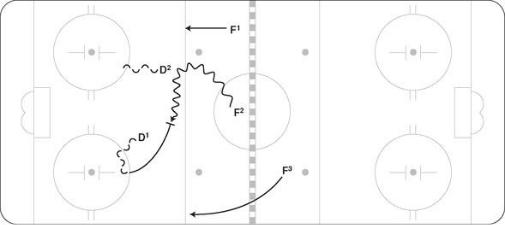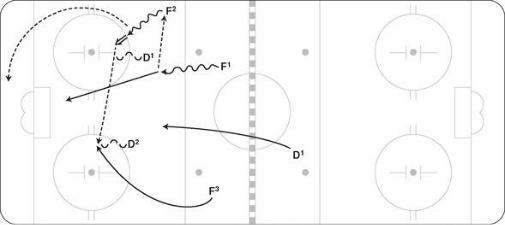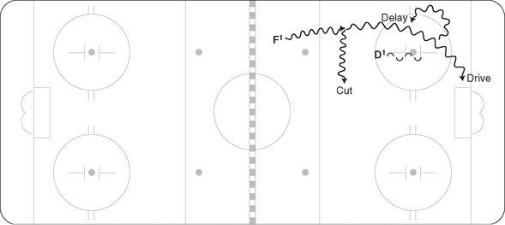
- •Foreword
- •Preface
- •Key to Diagrams
- •Reading Pressure and Options
- •Reacting to Support the Breakout
- •Breakout Plays
- •Control Breakouts
- •Counters
- •Regroups
- •Dump-In Entries
- •Mid-Ice Entries
- •Wide-Lane Drives
- •The Funnel
- •Two-on-One Attacks
- •Two-on-Two Attacks
- •Three-on-Two Attacks
- •Offsides
- •Activating Defense Into Offensive Zone Entries
- •Cycling
- •Playing Behind the Net
- •Stretching the Zone: Low-High Plays
- •Activating Defense in the Offensive Zone
- •Attack Zone Plays
- •Power-Play Breakouts
- •Gaining and Maintaining Possession off the Entry
- •Zone Setup
- •Five-on-Three Power Play
- •Four-on-Three Power Play
- •Forechecking Systems
- •Neutral Zone Forechecking
- •Neutral Zone Forechecking Systems
- •Neutral Zone Backchecking
- •Neutral Zone Backchecking Systems
- •Handling Defensive Zone Entries
- •Defensive Zone Systems
- •Situational Guidelines for Defensive Zone Coverag
- •Face-Offs and Penalty Kills
- •Forechecking and Penalty Kills
- •Pressuring the Entry
- •Defensive Zone Play
- •Three-on-Five Penalty Kill
- •Three-on-Four Penalty Kill
- •Offensive Zone Face-Offs
- •Neutral Zone Face-Offs
- •Defensive Zone Face-Offs
- •Power-Play Face-Offs
- •Penalty-Kill Face-Offs
- •Special Face-Off Situations
- •Managing Staff
- •Dealing With Officials
- •Adjusting Your Playing Strategy
- •Managing Lines
- •Line Changes
- •Handling the Moment
- •Index
- •About the Authors

Mid-Ice Entries
Most coaches prefer outside-drive entries because there is usually less chance for a dangerous turnover. Players who enter the offensive zone with the puck in the middle of the ice face several risks. The major concern is that any sideways movement in the middle of the ice brings with it the opportunity for the defenseman to stand up and make an open-ice hit. Most major (Scott Stevens or Dion Phaneuf-like) open-ice hits occur as players are carrying the puck into the middle of the ice on offensive zone entries (figure 3.6).
Figure 3.6 Mid-ice entry open-ice hit.
Many talented and offensively gifted players use this middle-ice space to pass off to teammates coming from behind the play with speed. This entry tactic is exceptional when executed properly because backspeed—players moving from behind the puck carrier

with more speed than the puck carrier—can completely catch defenders off guard.
The back-side pass upon middle entry (figure 3.7) is the most difficult to execute because it requires more skill, but it is always the most effective. Players gifted with the puck often carry it across the middle of the offensive zone just inside the blue line and then pass back toward the space where they have just come from to a player with vertical speed. The effectiveness of this entry comes from shifting the defenders sideways, with the puck carrier thereby opening up space for the player on the back side to enter the zone.
Figure 3.7 Mid-ice entry back-side pass.
A second option for the puck carrier in mid-ice (F1) is to drive across the line through the middle and then bump the puck to the outside player stationary at the blue line (F2). As F1 continues to drive to the net, this will free up space and time for F2 to shoot or make a play. F2 will have the option to shoot with F1 screening the goaltender, pass across to F3, or hit the late D1 moving in. If

there are no options available, then F2 can lay the puck behind the net to F1 for low puck possession. This “ladder play” is one of the most effective plays for drawing the defense in tight as F1 enters the zone then pushing them back as F1 passes off and drives to the net. It definitely creates a lot of defensive coverage confusion (figure 3.8).
Figure 3.8 Midlane ladder play.
Wide-Lane Drives
The wide-lane drive is the most utilized offensive zone entry because this is the space most often available to the puck carrier. When the puck carrier enters the zone wide, he may have the option to drive deep and try to go around the defenseman or behind the net. Defensemen are usually intimidated by speed and want to protect the space inside, so they will initially give the puck carrier room on the outside and then try to cut the puck carrier off deeper in the zone. The puck carrier may also delay by driving deep and then cutting back up ice or driving and cutting inside. It is important to read options quickly as you enter the zone wide with speed. The puck carrier going wide needs to read where the open space is—if it is deep then drive around the defenseman; if it is in front then cut laterally across in front of the defenseman; if the defenseman closes quickly on the puck carrier then the best option may be to spin off and delay (figure 3.9).
Figure 3.9 The wide-lane drive with options to cut, drive deep, or delay.

